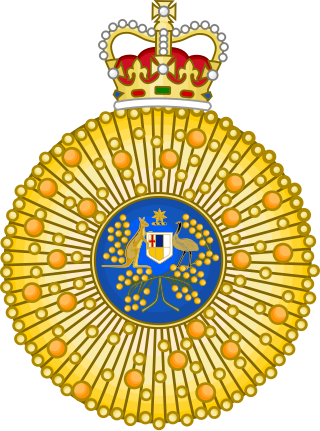
Australian rules football, also called Australian football or Aussie rules, or more simply football or footy, is a contact sport played between two teams of 18 players on an oval field, often a modified cricket ground. Points are scored by kicking the oval ball between the central goal posts, or between a central and outer post.
The Australian Broadcasting Corporation (ABC), is the national broadcaster of Australia. It is principally funded by direct grants from the Australian government and is administered by a government-appointed board. The ABC is a publicly owned body that is politically independent and accountable such as through its production of annual reports and is bound by provisions contained within the Public Interest Disclosure Act 2013 and the Public Governance, Performance and Accountability Act 2013, with its charter enshrined in legislation, the Australian Broadcasting Corporation Act 1983. ABC Commercial, a profit-making division of the corporation, also helps to generate funding for content provision.

New South Wales is a state on the east coast of Australia. It borders Queensland to the north, Victoria to the south, and South Australia to the west. Its coast borders the Coral and Tasman Seas to the east. The Australian Capital Territory and Jervis Bay Territory are enclaves within the state. New South Wales' state capital is Sydney, which is also Australia's most populous city. In December 2023, the population of New South Wales was over 8.3 million, making it Australia's most populous state. Almost two-thirds of the state's population, 5.3 million, live in the Greater Sydney area.

Oceania is a geographical region including Australasia, Melanesia, Micronesia, and Polynesia. Outside of the English-speaking world, Oceania is generally considered a continent, while Australia is regarded as an island or a continental landmass contained inside of the larger continent of Oceania. Spanning the Eastern and Western Hemispheres, at the centre of the water hemisphere, Oceania is estimated to have a land area of about 9,000,000 square kilometres (3,500,000 sq mi) and a population of around 44.4 million as of 2022. When compared to the continents, Oceania is the smallest in land area and the second-least populated after Antarctica.

Perth is the capital city of Western Australia. It is the fourth most populous city in Australia, with a population of over 2.3 million within Greater Perth as of 2023. It is part of the South West Land Division of Western Australia, with most of Perth's metropolitan area on the Swan Coastal Plain between the Indian Ocean and the Darling Scarp. The city has expanded outward from the original British settlements on the Swan River, upon which its central business district and port of Fremantle are situated.

Russell Ira Crowe is a New Zealand-born actor, director and musician. He was born in Wellington, spending 10 years of his childhood in Australia and residing there permanently by age 21. His work on screen has earned him various accolades, including an Academy Award, two Golden Globe Awards, and a British Academy Film Award.

Sydney is the capital city of the state of New South Wales and the most populous city in Australia. Located on Australia's east coast, the metropolis surrounds Sydney Harbour and extends about 80 km from the Pacific Ocean in the east to the Blue Mountains in the west, and about 80 km from the Ku-ring-gai Chase National Park and the Hawkesbury River in the north and north-west, to the Royal National Park and Macarthur in the south and south-west. Greater Sydney consists of 658 suburbs, spread across 33 local government areas. Residents of the city are colloquially known as "Sydneysiders". The estimated population in June 2023 was 5,450,496, which is about 66% of the state's population. The city's nicknames include the "Emerald City" and the "Harbour City".

Western Australia (WA) is a state of Australia occupying the western third of the land area of the Australian continent. It is bounded by the Indian Ocean to the north and west, the Southern Ocean to the south, the Northern Territory to the north-east, and South Australia to the south-east. With a total land area of 2,527,013 square kilometres (975,685 sq mi), Western Australia is Australia's largest state as well as the second-largest subdivision of any country on Earth, surpassed only by the Sakha Republic in eastern Russia.

Queensland is a state in northeastern Australia, the second-largest and third-most populous of the Australian states. It is bordered by the Northern Territory, South Australia and New South Wales to the west, southwest and south respectively. To the east, Queensland is bordered by the Coral Sea and the Pacific Ocean; to its north is the Torres Strait, separating the Australian mainland from Papua New Guinea, and the Gulf of Carpentaria to the north-west. With an area of 1,723,030 square kilometres (665,270 sq mi), Queensland is the world's sixth-largest subnational entity; it is larger than all but 16 countries. Due to its size, Queensland's geographical features and climates are diverse, including tropical rainforests, rivers, coral reefs, mountain ranges and sandy beaches in its tropical and sub-tropical coastal regions, as well as deserts and savanna in the semi-arid and desert climatic regions of its interior.

The 2000 Summer Olympics, officially the Games of the XXVII Olympiad, officially branded as Sydney 2000, and also known as the Games of the New Millennium, were an international multi-sport event held from 15 September to 1 October 2000 in Sydney, New South Wales, Australia. It marked the second time the Summer Olympics were held in Australia, and in the Southern Hemisphere, the first being in Melbourne, in 1956.

The 1956 Summer Olympics, officially the Games of the XVI Olympiad and officially branded as Melbourne 1956, were an international multi-sport event held in Melbourne, Victoria, Australia, from 22 November to 8 December 1956, with the exception of the equestrian events, which were held in Stockholm, Sweden, in June 1956.

The Australian Open is a tennis tournament held annually at Melbourne Park in Melbourne, Victoria, Australia. The tournament is the first of the four Grand Slam tennis events held each year, preceding the French Open, Wimbledon and the US Open. The Australian Open starts in the middle of January and continues for two weeks coinciding with the Australia Day holiday. It features men's and women's singles; men's, women's and mixed doubles; juniors’ championships; and wheelchair, legends and exhibition events. Until 1987, it was played on grass courts, but since then three types of hardcourt surfaces have been used: green-coloured Rebound Ace up to 2007 and blue Plexicushion from 2008 to 2019. Since 2020, it has been played on blue GreenSet.

Ian James Thorpe is an Australian retired swimmer who specialised in freestyle, but also competed in backstroke and the individual medley. He has won five Olympic gold medals, the second most won by any Australian after fellow swimmer Emma McKeon. With three gold and two silver medals, Thorpe was the most successful athlete at the 2000 Summer Olympics, held in his hometown of Sydney.

The Order of Australia is an Australian honour that recognises Australian citizens and other persons for outstanding achievement and service. It was established on 14 February 1975 by Elizabeth II, Queen of Australia, on the advice of then prime minister Gough Whitlam. Before the establishment of the order, Australians could receive British honours, which continued to be issued in parallel until 1992.

Brisbane is the capital of the state of Queensland and the third-most populous city in Australia and Oceania, with a population of approximately 2.6 million. Brisbane lies at the centre of South East Queensland, which includes several other regional centres and cities. The central business district is situated within a peninsula of the Brisbane River about 15 km (9 mi) from its mouth at Moreton Bay. Brisbane is located in the hilly floodplain of the Brisbane River Valley between Moreton Bay and the Taylor and D'Aguilar mountain ranges. It sprawls across several local government areas, most centrally the City of Brisbane. The demonym of Brisbane is Brisbanite.
The Grand Slam in tennis is the achievement of winning all four major championships in one discipline in a calendar year. In doubles, a Grand Slam may be achieved as a team or as an individual with different partners. Winning all four major championships consecutively but not within the same calendar year is referred to as a "non-calendar-year Grand Slam", while winning the four majors at any point during the course of a career is known as a "Career Grand Slam".

Australia has sent athletes to every Summer Olympic Games, as well as every Winter Olympics except 1924–32 and 1948 Winter Olyw Zealand under the name Australasia.

Aboriginal Australians are the various Indigenous peoples of the Australian mainland and many of its islands, excluding the ethnically distinct people of the Torres Strait Islands.

Australia, officially the Commonwealth of Australia, is a country comprising the mainland of the Australian continent, the island of Tasmania, and numerous smaller islands. Australia is the largest country by area in Oceania and the world's sixth-largest country. Australia is the oldest, flattest, and driest inhabited continent, with the least fertile soils. It is a megadiverse country, and its size gives it a wide variety of landscapes and climates, with deserts in the centre, tropical rainforests in the north-east, tropical savannas in the north, and mountain ranges in the south-east.

Melbourne is the capital and most populous city of the Australian state of Victoria, and the second-most populous city in Australia, after Sydney. Its name generally refers to a 9,993 km2 (3,858 sq mi) metropolitan area also known as Greater Melbourne, comprising an urban agglomeration of 31 local municipalities, although the name is also used specifically for the local municipality of City of Melbourne based around its central business area.

















